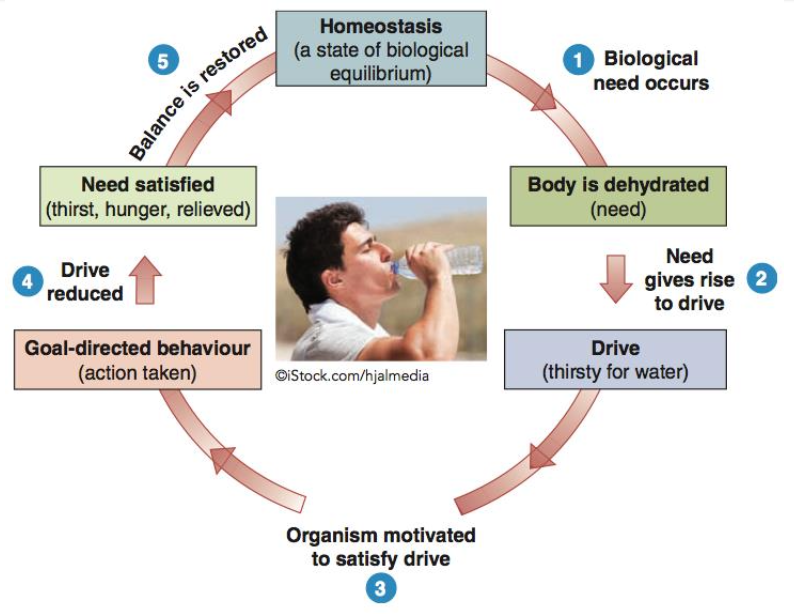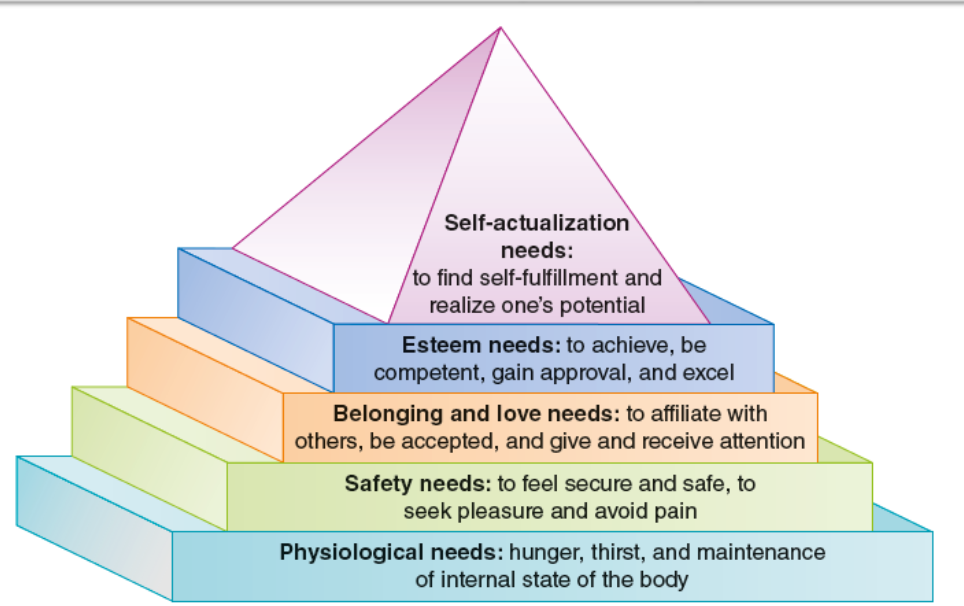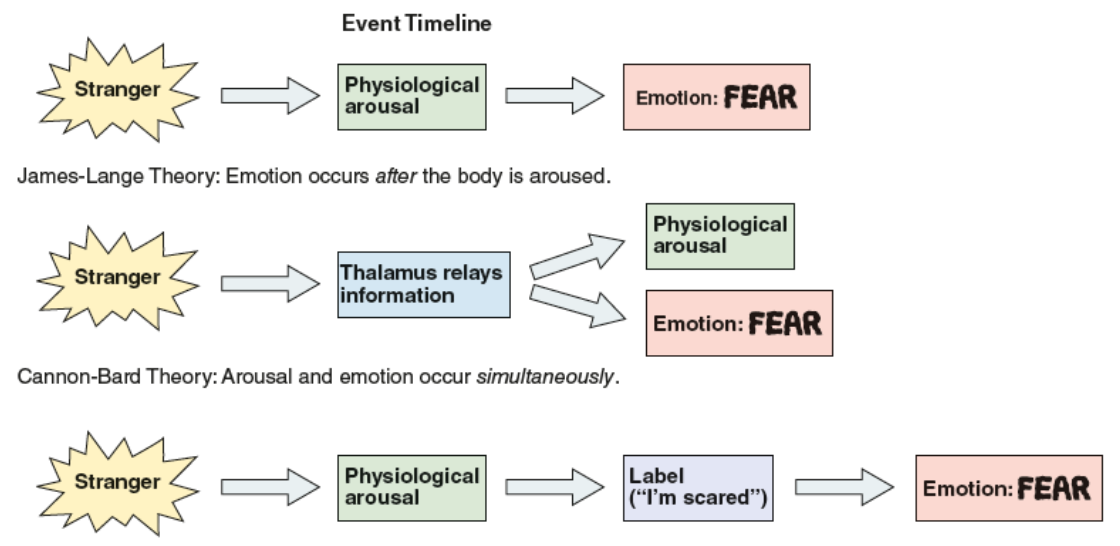Chapter 11 - Motivation & Emotions
1/40
There's no tags or description
Looks like no tags are added yet.
Name | Mastery | Learn | Test | Matching | Spaced |
|---|
No study sessions yet.
41 Terms
Define motivation
Any internal process or condition that directs behvaiour
What are the five theories of motivation
Instinct
Behaviour is motivated by instincts that are inborn and that are activated by environmental stimuli
Drive reduction
Behaviour is motivated by biological needs to maintain the body in a state of balance or equilibrium
Arousal
Behaviour is motivated by the need to achieve optimum levels of arousal
Incentive
Behaviour is motivated by internal (intrinsic) or external (extrinsic) incentives or rewards
Hierarchy of needs
Behaviour is motivated by the current most basic need
Basic survival needs must be satisfied first before we are motivated to satisfy higher-level needs such as belonging and self esteem
What is the instinct theory
People are motivated by their biological (innate) instincts
Instincts are inborn behavioural tendencies, activated by stimuli in our environments
e.g. newborn reflexes, certain social behaviours
What is the drive reduction theory
Physiological need creates an aroused state that drives us to reduce that need
We are motivated to restore balance or equilibrium - homeostasis
Pushed by biological, inborn needs (similar to instinct)
Pulled by incentives in environment

What is the arousal theory
We are motivated to pursue an optimum level of stimulation (arousal)
Different than drive reduction which is about returning to homeostasis
Some motivated behaviours increase arousal
Some motivated behaviours decrease arousal
What is Yerkes-Dodson Law
Arousal increases performance up to a certain point, after which it interferes with performance
The optimal level of arousal depends on whether it’s an easy or difficult

What is the Incentive theory of Motivation
Incentives: external motives that signal rewards.
Intrinsic Motivation – doing something for its own satisfaction (linked to quality of performance).
Extrinsic Motivation – doing something for external rewards (grades, money, recognition); linked to quantity of performance.
What is the difference between primary and secondary incentives
Primary - rewards (food) or punishments (pain) that are innate
Secondary - cues that are viewed as rewarding as a result of learning about their association with other events (work for money)
What happens in the brain during pleasurable experiences and motivation?
Opiate release → reduces pain, creates pleasure.
Dopamine pathway: Ventral Tegmental Area (VTA) → Nucleus Accumbens → Prefrontal Cortex = reinforces rewarding behaviour
This pathway motivates future behaviour by linking actions with rewards.
What is Maslow’s Hierarchy of Needs
Physiological needs
Physical survival (food, water, sex)
Safety needs
Need to feel safe and secure
Belonging and love needs
Close relationships with others
Esteem needs
Need to feel good about oneself
Self-actualization needs
Need to become all that one is capable of becoming

What are three biological motives
Hunger
We must replenish nutrients and energy & we are motivated to do so
Thirst (bodies are 60% water)
Motivated to drink water to maintain the volume in our bodies
maintain the ions-to-water balance inside cells
Sex
Biological (evolutionary), social and cultural motivation
What are some cues for us to eat
Empty stomach and levels of nutrients in our bloodstream
Levels of glucose, lipids, and leptin
Lipids - produced when body breaks down fats from food
Leptin- released from fat cells as they grow
Lateral hypothalamus (LH) signals hunger and thirst
What are some cues for us to stop eating? What happens if these mechanism stop working?
Ventromedial region of the hypothalamus (VMH) signals satiety
Dysfunction of the ventromedial hypothalamus = no satiety signal
Prader-Willi syndrome
What is a body weight set point
A weight that individuals typically return to, even after dieting or overeating
Permanent eating and exercise changes as well as monitoring weight override set point controls
What classifies/causes obesity
BMI of over 30
Genetic, environmental/social (portion sizes, social eating, etc) and psychological (self-regulation) effects all can cause obesity
What is Anorexia Nervosa and how is it treated?
Eating disorder marked by under-eating and extreme dieting.
Features:
Preoccupation with being fat
Distorted body image
Dangerous weight loss
10% fatality rate
More common in females (1 in 300 young women in Canada)
Treatment: Cognitive-behavioural therapy, nutritional counselling, hospitalization, family therapy.
What is Bulimia Nervosa and how is it treated?
Eating disorder with a cycle of binge-eating followed by purging (vomiting, laxatives, excessive exercise).
Features:
Medical & dental problems
Secretive, shameful behaviours
Most not underweight
More common in females (1/100 young women in Canada)
Linked to OCD, anxiety, depression, and self-harm
Treatment: Behaviour modification, reward healthy habits, cognitive therapy, healthier self-image, antidepressants or other medications.
What is Binge-Eating Disorder and how is it treated?
Eating disorder marked by out-of-control eating large amounts of food.
Features:
Occurs multiple times per week over months/years
Eating rapidly, even when full
Done alone, followed by guilt/shame
Causes psychological distress and negative emotions
More common in women and people with obesity
Treatment: Cognitive-behavioural therapy (CBT), antidepressant medication.
What happens to the body during sexual activity
Excitement: This is the beginning of arousal and it can last up to several hours. Heart rate quickens, though not constantly over a long period of time.
Plateau: At this phase, breathing and pulse rates increase. Muscles tense and a flush may appear across the chest.
Orgasm: Muscle tension and blood pressure reach a peak. This is quickly followed by climax, which is a series of muscle contractions (the intensity varies, particularly among women).
Resolution: Muscles relax and heart rate returns to normal. While men have a refractory period after an orgasm, during which they cannot ejaculate, women may have additional orgasms.
What happens in the brain during sexual activity
Reproductive hormones influence sex drive, the pursuit of sexual behaviour, and sexual response
Sexual activity and sexual images activate:
Frontal lobes
Basal ganglia
Hypothalamus
Amygdala
Ventral Tegmental Area (VTA): activated during early-stage, intense romantic love and when viewing photos of loved ones (even without sexual interest).
What are the gender differences in sexuality according to evolutionary psychology?
Men: Prefer mates who increase odds of reproductive success.
Women: Prefer mates who can provide for and protect offspring.
These differences are thought to have evolved to maximize reproduction and survival of children.
What is sexual orientation
One’s relative attraction to individuals of varied genders and contains four related phenomena:
Sexual behaviour
Sexual identity
Sexual attraction
Sexual arousal
What are the four components of Sexual Orientation?
Sexual Behaviour – range of sexual behaviours and partners.
Sexual Identity – how a person defines their orientation, whether or not shared with others.
Sexual Attraction – who a person is sexually attracted to.
Sexual Arousal – extent of arousal to erotic stimuli involving different genders.
Conscious vs Unconscious motivations
Conscious motivations– motivations that people are aware of and can verbalize
Unconscious motivations– motivations that people are unaware of and cannot verbalize
Take caution when explaining people’s behaviour with
unconscious motivations
Approach vs Avoidance motivation
Avoidance - the desire to avoid the experience of a negative outcome following a behaviour
Approach - the desire to experience a positive outcome following a behaviour
What is the hedonic principle
We avoid painful experiences and approach pleasurable experiences
What is loss aversion
A tendency to be motivated more strongly to avoid a loss rather than to achieve a gain, even if the potential loss and gain are of equal size
What are intrinsic, extrinsic, and amotivation?
Intrinsic Motivation – doing something for internal satisfaction.
Extrinsic Motivation – doing something for external rewards (e.g., money, grades).
Amotivation – state of having no motivation (though it may reflect other underlying factors, not true absence of motivation).
What is the fixed vs growth mindset
Growth - a belief that hard work and effort can improve a person’s skill or talent in a particular area
Fixed - a belief that talent is innate and that skill in a particular area is not determined by hard work and effort
Grit - long-term perseverance toward a goal
What is affiliation motivation?
Need to form attachments for support and protection.
Benefits: higher self-esteem, less depression, longer life.
Drawbacks: stay in abusive relationships or political polarization to feel like they belong
Brain: Social exclusion activates anterior cingulate cortex (like physical pain)
long-term isolation can lead to permanent psychological damage
What is achievement motivation?
Self-Determination Theory: driven by competence, relatedness, autonomy
Can be intrinsic (learning) or extrinsic (rewards) motivated to learn new things
Linked to competition
Too much focus on rewards → more distress after failure
How is achievement related to delaying gratification?
Achievement requires long-term goal pursuit.
Involves delaying gratification and impulse control.
These skills depend on the prefrontal cortex, which matures after puberty.
Ability to wait for rewards is key to success.
What are the four components of emotion
Physiological - changes in bodily arousal
HR, temperature, and respiration
Cognitive, feeling - subjective appraisal and interpretation of one’s feelings and environment
Physical, behavioural - expression of the emotion verbally and non-verbally
Smiling, frowning, whining, laughing, reflecting, slouching
Emotional, behavioural - keeping the emotion present (happiness) or removing it (sadness)
What are three ways to measure emotions
Behavioural displays of emotions
Observe behaviour and facial expression
Self-reports of emotion
Widely used, but has low validity
Psychophysiological reactions
Face electromyography
HR
Skin conductance
fMRI
What are the functions of emotions
Cognitive
help organize and retrieve memories
prioritize concerns, needs, goals and helps with judgement
Behavioural
emotions alter behaviours
action tendencies (emotions are associated with predictable behaviours)
Social
Emotions are the foundation of relationships, help improve relationship quality and helps with empathy & work performance
What are the three major theories of emotion?
James-Lange Theory – emotions result from physiological changes.
Cannon-Bard Theory – emotions and bodily arousal occur simultaneously.
Schachter & Singer’s Two-Factor Theory – emotion = physiological arousal + cognitive interpretation.

What are two other theories of emotion?
Cognitive-Mediational Theory (Lazarus): Emotions depend on cognitive appraisal, which mediates between environmental stimuli and our reactions.
Facial-Feedback Theory: Facial muscle activity influences emotional experience (e.g., smiling can make you feel happier). Evidence is mixed/weak.
What is the survival function of emotions?
Evolutionary Theory: Emotions are innate, passed through generations because they aid survival.
Basic emotions: Universal across cultures (fear, anger, joy, sadness, surprise).
Survival links:
Threat → Fear/Anxiety → Fight or flight
Obstacle → Anger/Rage → Aggression/defense
Potential mate → Joy/Excitement → Courtship, mating
Loss → Sadness/Grief → Crying for help
Novelty → Surprise → Stop & pay attention
What happens in the brain during emotion?
No single brain structure controls a specific emotion.
Emotions arise from circuits of interconnected brain regions working together.
The activation of these circuits (not just individual structures) produces our conscious experience of emotion.
Medial prefrontal cortex, the medial parietal lobe, temporal lobe, thalamus, hippocampus, and amygdala, and the circuitry between these structures, contribute to our experience of emotions
What is positive psychology
The study and enrichment of:
Positive feelings - happiness, optimism
Positive trains - perseverance, wisdom
Positive abilities - interpersonal skills
Virtues - altruism, tolerance
What factors are linked to happiness?
Tend to be optimistic, outgoing, curious, tender-minded, high self-esteem, spiritual, goal-directed, sense of control.
Health benefits: highly optimistic people had 55% lower risk of death and 23% lower risk of heart problems.
Cultural variation: Definitions and value of happiness differ across cultures.